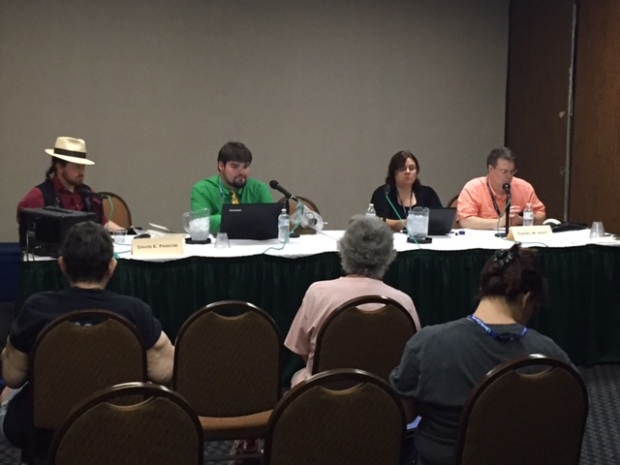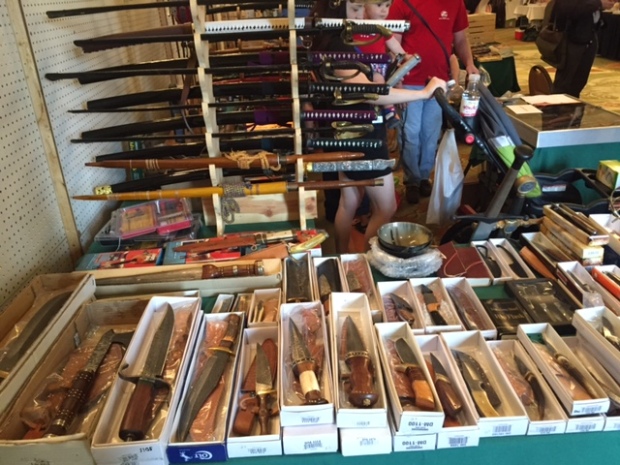I’m back from LibertyCon in Chattanooga, Tennessee. It’s a smallish, old-school SF&F convention, limited to 750 people, and definitely tending toward military SF and Baen Books authors. One of the best things about it is the author-fan ratio — heavily tilted toward authors, so unlike most bigger cons, you have a good chance of spending a little quality time with your favorite authors up-close and personal, and authors have more time to hobnob with each other.
It’s also a little harder to get to since Chattanooga is a small city with limited air connections. Most fan attendees live close enough to drive. Coming from a small city in California, I was lucky to get there with only two hops, three on the way back. Many fly into Atlanta or Nashville and rent a car to drive the rest of the way.
The venue: The Chattanooga Choo Choo, a hotel built around the old train station, with several old buildings scattered around the station and two “trains” of passenger cars repurposed as hotel rooms. The conference center across the street is just the right size for the con. Be prepared to do a lot of walking if your room is in faraway Building 3!
Some photos of the facilities:
The first day I felt a bit out of it. It was like going to a party where you don’t know anyone, but they are all good friends. Being typically introverted, it took me awhile to start meeting people. I dropped into Sarah Hoyt’s room party and started meeting people I knew from FB but had never met IRL — Sarah and her family, Paul and Sarah Clithero, Dorothy and Peter Grant, Tully Roberts, and more. Larry Correia dropped in — I expected him to be bigger!
The next day I was on a panel about Militarized AI, which was my first panel experience — no one died! Good conversation with smart people. And some audience members (hi, Sub Man!) knew more than we did about their specialist fields.
One obvious difference at LibertyCon — it’s a Red Tribe con, meaning most attendees are in the liberty-loving, military-respecting, rural-BBQ-and gun-loving population typical of the US away from the coastal urban enclaves. Since I grew up with those people and understand them well, I’m not frightened by guns, blades, military uniforms, seared meat, or the occasional less-than-sensitive remark.
In more Blue Tribe and progressive terrain, it is entirely possible for one intersectional-class person (say, a lesbian) to commit heinous offenses against another (say, a gay man) which will be a subject of endless commentary and second-guessing by an online community positively eager to defend the weak from slights they didn’t witness by people they don’t know. Many in the social justice headspace need rules and some daddy-authority to back them up over often-imagined sins — not that there aren’t real assholes around, but I encountered none in the homeland of the militaristic Baen Books-loving racist-sexist-homophobes (that’s a reference to a certain editor at Tor’s comments.)
The following day I was on a panel in the big theater on Military SF as probably the least experienced in actual military service — I am more the analyst type, trying to understand defense and military issues from book learning and analysis. Which was one of the main topics: can you write effective and engaging military SF without any actual military experience? We concluded you could, with enough research and consulting with the more experienced, since there are plenty of examples of convincing novels written by armchair soldiers. The panel included Doug Dandridge, Charles E. Gannon, Peter Grant, James Young, and Kal Spriggs (who can all out-talk me about anything military) — so I felt honored to be included. I must have been chosen to fill in for someone like Brad Torgersen, who couldn’t make it. I was a little shaky since that’s the biggest audience I’ve been in front of since I was on a similar panel questioning Jonas Salk around 1974.
After that panel, one of my readers came up to say kind things about my books. I wanted to take him home with me for moral support. I don’t have that many readers yet, but it was a nice surprise.
Here are some photos of various sessions I attended:
One interesting session featured Peter and Dorothy Grant discussing self-publishing, contracts, marketing, and the alternative publishing houses like Castalia House offering better deals for authors than the Big Five:
This was interesting, since while I get much higher royalties publishing myself, I don’t get good distribution outside Amazon, which is the one thing Big 5 publishers still have to offer. The situation is fluid, but anyone waiting for a contract with a traditional publisher is probably making a big mistake at this point – if your work is good and you are able to do some promotion, you will do better on your own. Advances for SF&F novels from the Big 5 are down to $3K or so and most don’t earn out. Is $3K per novel enough to survive on? No. Meanwhile, a few years of writing quality, entertaining books can bring in enough to live on through ebook sales alone, and more if you’re willing to produce your own audiobooks. They comment that publishers now look for guaranteed sellers, meaning one of the few ways to get their attention is to already be successful as a self-published author — if your fan base is big enough, they need you more than you need them. Meanwhile, conventional publisher slush piles take six months to a year to return a 99.9%-probable form rejection.
Dropping into the vendor area:
At the airport waiting for my flight out, I ran into Chuck Gannon (who had been at the other end of the Military SF panel) finishing a plate of french fries. He reassured me I did okay on the panel, giving me this blurb-worthy quote: “A distinctive voice!” — Chuck Gannon
LibertyCon is a close-knit, fun group — for many there, the family they wish they had. I hear the 2017 memberships are already up to 500 of the 750 limit, so if you want to go, sign up soon.











If I could describe the “Red State” side of the SF/F publishing industry, I’d describe it like this:
1) Having fun
2) Entertaining the fans
3) Making money
4) No sticks up asses
Too often, the “Blue State” side of the SF/F publishing industry likes to pose and preen in the mirror; certain of its intellectual and moral magnificence.
Of course, it’s a clever modern sleight-of-hand that the colors (red, blue) have been inverted. For it is the RED side–cultural marxism–that reigns in the halls of our oh-so-sensitive and conscientious betters. Plenty of sticks up asses, over there. In fact, I think they issue you a stick at the door, with instructions for insertion. 😉
LikeLike
The red – blue labels came into use in the 2000 election when the colored maps the networks used were set up as red for Republican and blue for Democrat. That stuck, so the blues being reddish sorts (more pink) of previous eras is confusing. I associate blue states with the blue bloods of New England, which together with the Quaker thread of PA had the Puritan controlling tendency still seen in progressives today.
LikeLike
To be specific, the red/blue denotations originated in the 1976 Presidential election (the first one where it was presumed that EVERYONE in the US had access to, if not actually owned, a color television set), and at that time RED = DEMOCRAT (fittingly enough) and BLUE = REPUBLICAN. It was in 2000 that the color assignments switched and became standard usage by all of the reporting networks, something I found intriguing due to the visual cues that I believed the Big 3 and CNN were attempting to signal to the public.
LikeLike
You did a nice job on the panel, and analysts DO play a part… 🙂
LikeLike